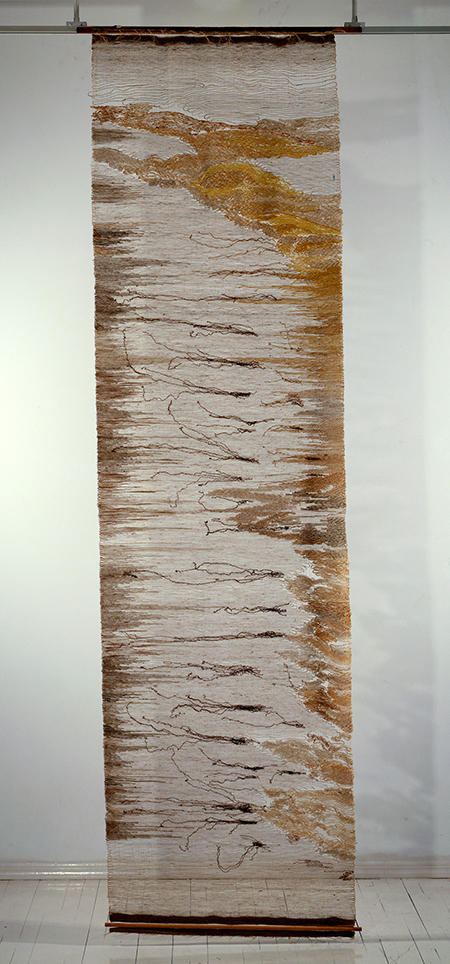
Continuing through August 27, 2017
For a small show, this exhibition packs a punch. Containing just 27 paintings, drawings and sculptures by Lenore Tawney, Agnes Martin, Ellsworth Kelly, Jack Youngerman, Robert Indiana and Chryssa, “Between Land and Sea: Artists of the Coenties Slip" effectively conveys the importance and influence of a decade of artistic creation and collaboration at the lower tip of Manhattan. It is still known as Coenties Slip today, even though there has not been water there since the 1880s. The “slip,” or inlet of water, was artificially created in 1699, and after ships began unloading cargo there, warehouses were built for storage and to accommodate sail-making and other seagoing industries. All that remains of Coenties Slip today is two blocks running between Pearl and South streets.
The period during and immediately following World War II was a fertile time for art in New York City. By the 1950s, first-generation abstract expressionists such as Pollock, DeKooning and Kline were holding court at the Cedar Tavern in Greenwich Village, while the artists in this show were feeling somewhat estranged from that gestural painting style. Many artists and writers were living in the Coenties Slip area at the time, as the warehouses were inexpensive, had great light and featured expansive views of the East River and Brooklyn Bridge. Although most lofts had no hot water, heat or kitchens, the Seamen’s Institute nearby had a cafeteria and warm showers.
According to Stephanie Barron (Art in America, March 1974), artist Fred Mitchell was the first to arrive. After spending three years in Rome, he moved to 31 Coenties Slip in 1954. Kelly, a friend of Mitchell’s, went to visit him upon his return from seven years in Paris. He rented a loft on nearby Broad Street but moved to 3-5 Coenties Slip in 1956. Indiana visited Kelly and soon left his Tenth Street studio, where he was surrounded by abstract expressionists, for 31 Coenties Slip. That same year, Youngerman returned from Paris and visited Kelly. In 1957, he moved to 27 Coenties Slip with his wife and son. James Rosenquist, a friend of Indiana’s, took over Martin’s loft at 3-5 Coenties Slip when she moved, and even Cy Twombly lived there briefly in 1956. Barnett Newman, Jasper Johns and Robert Rauschenberg lived on Pearl and Front streets just blocks away. The Coenties Slip artists were constantly fighting the City of New York to keep developers at bay, but by the mid-1960s, it was mostly over. Mitchell, the first to arrive, was the last to leave in 1967.
The six artists of the Coenties Slip had much in common. They shared a desire to find an innovative approach to abstraction, blending that with a deep appreciation of nature. Youngerman grew flowers on the roof that he used in his drawings and paintings. Tawney’s large open-weave tapestry “Seaweed” (1961) suggests the delicate floating aquatic plants, and Martin’s “Horizon” (1960) suggests a series of waves executed in a muted bluish gray. Kelly’s five sketches that comprise “Tablet #65” include an image of a large schooner passing under the Brooklyn Bridge and other ship imagery.
Kelly and Youngerman took advantage of their large lofts to expand the size of their work. Kelly’s “Rouleau Bleu” (1951) is nearly 10 feet long but only 17 inches tall, its blue and white colors and horizontal format suggesting the water that surrounded them. Indiana was influenced by Kelly to turn away from Sheeler, Demuth and Hopper and experiment with geometric abstraction, as seen in “Gingko” (1959) and “Coenties Slip” (1960). Martin, Tawney and Chryssa were interested in minimalism, as well as craft mediums and techniques. Martin and Tawney were looking at Native American art, and Chryssa’s work was inspired by ancient Cycladic sculpture. By this time, Martin was creating paintings like “Island I” (1960), which incorporated elements of the grid that would occupy her for the rest of her life. For these artists, Coenties Slip was a kind of oasis, a world apart from the rest of Manhattan, a crucible where these artists were able to develop an innovative aesthetic in the early fifties that served as precursors of minimalism and pop art.
“So there I was right on the river, looking at the river and the boats and the lights of Brooklyn,” Tawney told Paul Cummings in 1971. “I had a stove for heat, and sometimes when the wind was blowing hard, I couldn’t get the fire going, and it was very cold. But it was beautiful.” (Smithsonian Archives of American Art).
